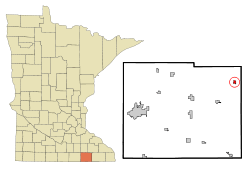Racine, Minnesota
Racine is a city in Racine Township, Mower County, Minnesota, United States. The population was 442 at the 2010 census.[6]
Racine | |
|---|---|
 Location of Racine, Minnesota | |
| Coordinates: 43°46′35″N 92°28′56″W | |
| Country | United States |
| State | Minnesota |
| County | Mower |
| Area | |
| • Total | 0.67 sq mi (1.73 km2) |
| • Land | 0.67 sq mi (1.73 km2) |
| • Water | 0.00 sq mi (0.00 km2) |
| Elevation | 1,293 ft (394 m) |
| Population | |
| • Total | 442 |
| • Estimate (2019)[3] | 593 |
| • Density | 887.72/sq mi (342.81/km2) |
| Time zone | UTC-6 (Central (CST)) |
| • Summer (DST) | UTC-5 (CDT) |
| ZIP code | 55967 |
| Area code(s) | 507 |
| FIPS code | 27-52882[4] |
| GNIS feature ID | 0649786[5] |
Geography
According to the United States Census Bureau, the city has a total area of 0.67 square miles (1.74 km2), all of it land.[8]
Demographics
| Historical population | |||
|---|---|---|---|
| Census | Pop. | %± | |
| 1960 | 180 | — | |
| 1970 | 197 | 9.4% | |
| 1980 | 285 | 44.7% | |
| 1990 | 288 | 1.1% | |
| 2000 | 355 | 23.3% | |
| 2010 | 442 | 24.5% | |
| Est. 2019 | 593 | [3] | 34.2% |
| U.S. Decennial Census[9] | |||
2010 census
As of the census[2] of 2010, there were 442 people, 157 households, and 122 families living in the city. The population density was 659.7 inhabitants per square mile (254.7/km2). There were 166 housing units at an average density of 247.8 per square mile (95.7/km2). The racial makeup of the city was 98.9% White, 0.2% African American, and 0.9% from two or more races. Hispanic or Latino of any race were 1.4% of the population.
There were 157 households, of which 42.0% had children under the age of 18 living with them, 65.6% were married couples living together, 5.7% had a female householder with no husband present, 6.4% had a male householder with no wife present, and 22.3% were non-families. 17.2% of all households were made up of individuals, and 6.4% had someone living alone who was 65 years of age or older. The average household size was 2.82 and the average family size was 3.20.
The median age in the city was 35 years. 30.5% of residents were under the age of 18; 5.8% were between the ages of 18 and 24; 31.4% were from 25 to 44; 22.9% were from 45 to 64; and 9.3% were 65 years of age or older. The gender makeup of the city was 51.1% male and 48.9% female.
2000 census
As of the census[4] of 2000, there were 355 people, 121 households, and 94 families living in the city. The population density was 804.4 people per square mile (311.5/km2). There were 123 housing units at an average density of 278.7 per square mile (107.9/km2). The racial makeup of the city was 99.15% White, 0.56% African American, and 0.28% from two or more races.
There were 121 households, out of which 43.0% had children under the age of 18 living with them, 70.2% were married couples living together, 5.8% had a female householder with no husband present, and 22.3% were non-families. 15.7% of all households were made up of individuals, and 7.4% had someone living alone who was 65 years of age or older. The average household size was 2.93 and the average family size was 3.31.
In the city, the population was spread out, with 30.4% under the age of 18, 7.3% from 18 to 24, 34.1% from 25 to 44, 20.3% from 45 to 64, and 7.9% who were 65 years of age or older. The median age was 33 years. For every 100 females, there were 91.9 males. For every 100 females age 18 and over, there were 102.5 males.
The median income for a household in the city was $53,750, and the median income for a family was $58,125. Males had a median income of $36,607 versus $28,958 for females. The per capita income for the city was $19,755. None of the population or families were below the poverty line.
Notable Residents
- Ming of Harlem, born in Racine
References
- "2019 U.S. Gazetteer Files". United States Census Bureau. Retrieved July 26, 2020.
- "U.S. Census website". United States Census Bureau. Retrieved 2012-11-13.
- "Population and Housing Unit Estimates". United States Census Bureau. May 24, 2020. Retrieved May 27, 2020.
- "U.S. Census website". United States Census Bureau. Retrieved 2008-01-31.
- "US Board on Geographic Names". United States Geological Survey. 2007-10-25. Retrieved 2008-01-31.
- "2010 Census Redistricting Data (Public Law 94-171) Summary File". American FactFinder. United States Census Bureau. Retrieved 27 April 2011.
- Upham, Warren (1920). Minnesota Geographic Names: Their Origin and Historic Significance. Minnesota Historical Society. p. 361.
- "US Gazetteer files 2010". United States Census Bureau. Archived from the original on 2012-07-02. Retrieved 2012-11-13.
- "Census of Population and Housing". Census.gov. Retrieved June 4, 2015.
Further reading
- Mill on the Willow: A History of Mower County, Minnesota by various authors. Library of Congress No. 84-062356
